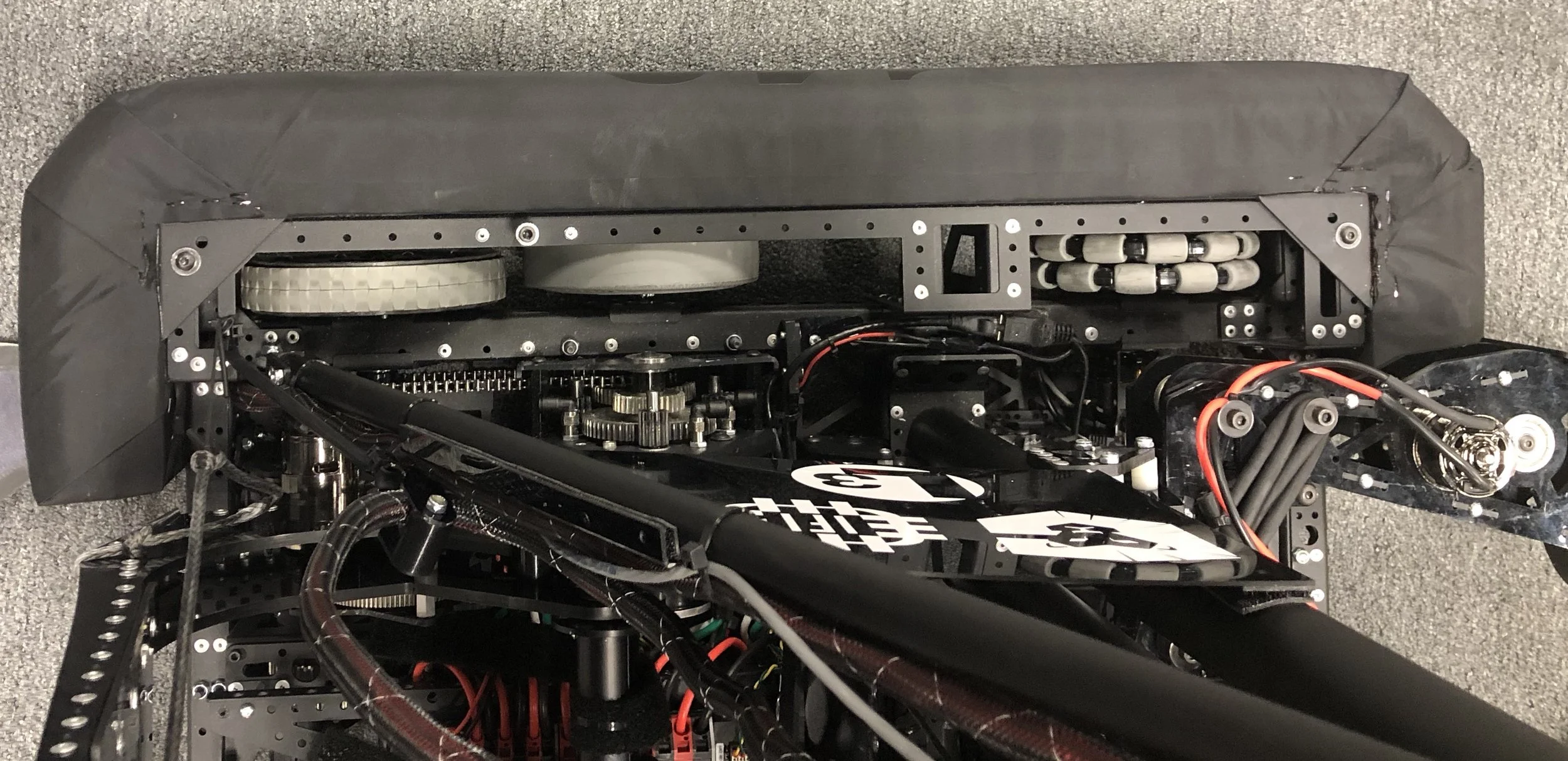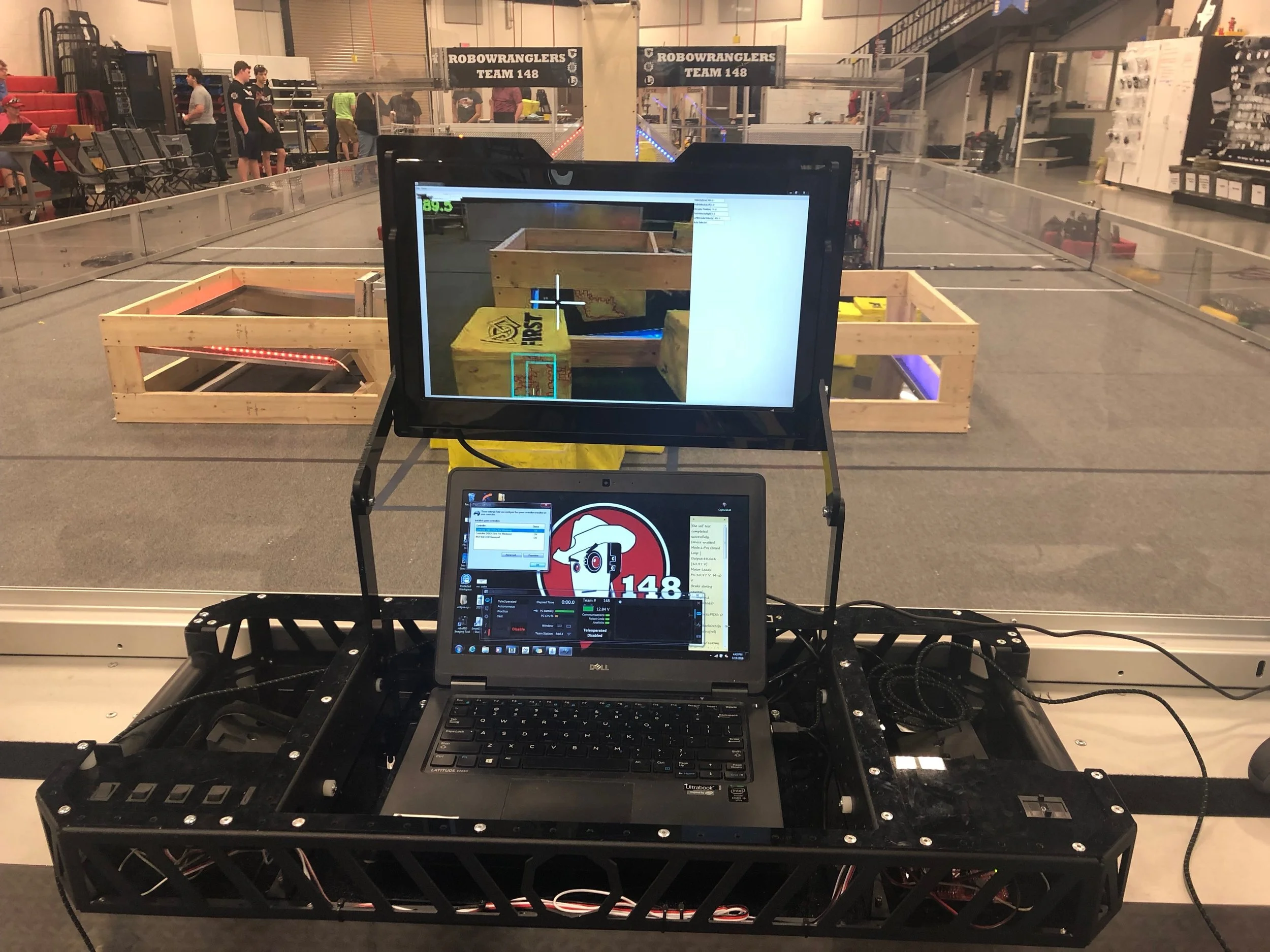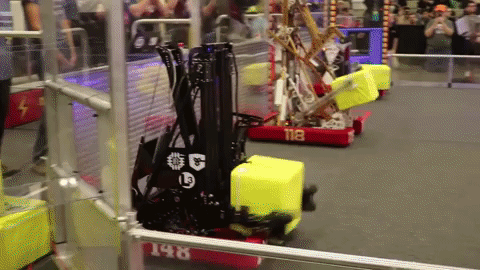2018 Single Stage Frc Continuous Elevator Lift System Design
We get a lot of questions about our robots. The team has compiled a list of the questions we most frequently get and I'm happy to answer them. Here's an inside look at some of Uppercut's details:
Overall Robot
Has your robot uppercut anyone?
No, but it has uppercut the scale a few times during match-play. It also likes to slap people who aren't paying attention with it's "satisfyingly floopy" front nose.
How do you make the robot?
Every robot is different. This one is a combination of Renegade and Raptor. We locked them in a room for 6-weeks, and played a lot of smooth jazz. When we came back, they had built Uppercut.
More seriously... I talked about our construction techniques in the Day 21/22 Update. Short version: lots of VEXpro, lots of prototyping, lots of CAD design, lots of sheet-metal, lots of CNC'd lexan #AllBlackEverything.
How many motors do you have?
We have 14 total motors and no pneumatics.
Drivetrain (6x) MiniCIM
Elevator (2x) 775pro
Intake (2x) 775pro
Climber (3x) 775pro
Robot Wrangler (1x) 775pro
How much does your robot weigh?
When we inspected at Dallas, the robot was 93.3 lbs
The red bumpers were 9.4 lbs
The blue bumpers were 9.6 lbs
Combined with a 14 lb battery, Uppercut weighs in around 117 lbs "battle ready."
We're continuing to push for "lighter". We are bringing some lightened drive wheels to Denver and have a few other things in work to reduce weight...
LOL, you broke something... maybe it should have been heavier!
You're probably right. Everything is iterative. The next version will be stronger.
How do you design your robot to be that light?
Light-weight construction techniques are a big part of it, but the best way to design a lightweight robot is to eliminate functionality. "You know what's better than something? NO thing." In pursuit of light weight we: decided to skip the pass-thru elevator, skip the 2 partner lift, design a partner climber which doesn't pass weight thru the robot structure, skipped the wrist joint and more...
How do you "do everything" while only weighing 93 lbs?
We don't do everything. We skipped over lots of features which other great teams have. Great features. Features that we wish we had. Sometimes we worry that we're being dumb by skipping them.
Are you guys dumb?
You probably won't believe this, but the #1 question we ask ourselves on 148 is: "Are we dumb?"
Do you have pneumatics?
Nope. Part of designing "light" is skipping pneumatics.
Do you wish you had pneumatics?
Sometimes. They're really handy when you want to add things late in the season. Whenever we want a little "trigger" mechanism it requires a lot more thought.
Can you walk me through the detailed design of XYZ component?
Maybe after the competition season is over, it takes time to put that kind of thing into (coherent) words.
Can you do the exchange?
Yes. We've put our share of cubes into the vault.


How many robots do you have?
We have three robots in various states of iteration.
Are all your robots black?
No, sadly. Only the competition robot is as black as we want it to be. Due to the way our manufacturing / assembly went this year, large parts of the practice/development robots are au naturel.

Do you believe everything you see on TV? Both of these robots are CGI.
How much does the robot cost?
I have no idea. We have a very generous engineering / development budget. The "CAWst" of the robot is within the FIRST rules, by a large margin.
When did you finish designing your robot?
"We don't understand the question... Finish... what does this word mean?"
Most of the design was done by late Week 3, early Week 4 of the build season. We did a LOT of iterative design since then, including lots of intake iterations...
Will you give us your CAD and Code?
Yes, we will do a full CAD release and code release sometime in the off-season.
Drivetrain
What type of drivetrain do you have?
It is a single-speed, 6WD. We refer to it as a "multi-configurable" 6WD because of how much we tweak the configuration.
Why do you have so many different wheels on your robot?
Lately we design our drivetrains to be reconfigurable, then tweak them as we go. As we tune the turning-dynamics, we swap wheels in and out with different frictional coefficients and add/remove omni wheels.
This year, we also tuned the robot for stability when the elevator was extended. By using traction wheels with slightly different diameters we can adjust the amount of "rock" the robot has while still tuning the robot's turning.
How come your 6WD isn't 6WD? We heard that 6WD needs to be like the ones the poofs do.
Look... we know our 6WD is really weird... It made sense at the time.

It made sense at the time...
No, really... are you guys dumb?
It's not like we'd have planned the drivetrain to be like this at the beginning of the build season.
I think the philosophy of "tune it over time" is a healthy way to approach drivetrain design.
Elevator
What is your elevator?
"It's just a few sticks and some bearings."
How is your elevator so fast?
This is a question we get a lot, and depending on who is asking, they could be talking about any number of things. A few aspects which make the elevator go fast:
1 - we make it as low-drag as possible.
2 - There is very little friction when sliding the stages, even when you put side-loads on the system.
3 - We have constant force springs (2x - 10.6lb springs) on the 3rd stage to counter balance some of the load the elevator needs to lift.
4 - We designed it (and everything that must go "up") to be as light a possible.
5 - Like most other teams we use closed loop control to end the elevator to pre-set positions. The operator chooses "high scale" and the elevator zips to that height, then she can manually adjust from there if needed.
6 - It is "over-powered" - we use (2x) 775pro motors on it.
What rollers/bearings do you use for your elevator?
3D-printed concave rollers, with embedded bearings.
We wanted to keep everything that goes up high lightweight. This led us towards thin-wall aluminum round tubes and interfacing with those led to concave rollers. Each roller has two tiny radial bearings and two tiny thrust bearings to keep it happy.
How do you attach to the round tubes?
We insert the tube into the robot's sheet-metal structure, and match drill holes through the holes pre-punched in the sheet-metal. We insert a 3D printed plug into the end of each tube. This plug has nylock nuts embedded in it. We rotate the plug/tube until all the holes align, then we bolt the whole thing together.
How do you control your elevator?
We have several pre-defined "set-points" which the operator can trigger using buttons on her controller. There is an additional fine adjustment control using an analog joystick. The elevator uses a US Digital encoder for position measurement. The elevator is driven by (2x) 775pro motors. We'll likely do a code release after the season is over.
Why is your elevator so over-powered? TWO 775pro motors? You don't even climb with that thing. We heard the Robonauts use a single BAG motor on their elevator.
We wanted to build a FAST elevator this year, and as such decided to over-power it. It seems to be working for us.
How much does the elevator weigh?
The elevator subsystem including the gearbox, all 3 stages w/carriage (but NO intake) is 15 lbs.
H ow does your elevator work?
It's a "cascade style" 3-stage elevator. The bottom stage is driven by a continuous loop of #25 chain (it pulls up, and down). The upper stages are driven by loops of amsteel-blue rope.
How do you tension your elevator chain?
The upper bearing block for the chain has tensioner screws, so if the chain loosens up we just tighten these and it's all good.
How do you tension your elevator ropes?
The ropes are tensioned by pulling them through a clamping block, then tightening the block down.
Why did you go round tube on the elevator?
Thin walled round tube is incredibly strong, and incredibly light. It can be challenging to attach to it (especially for a team that doesn't do welding) but has big upsides for some applications. This is the first time we've experimented with it.
Intake
How does your intake work?
We use spinning, grippy, compliant-wheels which are spring-loaded inwards. The backstop of the intake is designed to "roll" the cube up into place. We refer to this as the "boot" in reference to the mechanism on the Simbot 2015 robot which flipped the trash-cans up into place. We spend a lot of time tuning...
What are Spaaaaaace wheels?
Space Wheels is the nickname the Robowranglers gave to intake wheels the Robotnauts made for us in 2015. They're waterjet from neoprene sheet. We wanted to use Space Wheels again this year. This season we asked our friends at West Coast Products to make them for us, since NASA was potentially going to be affected by the government shut-down. Since they come from California we call those: "Hella Space Wheels."
The Robonauts also made some of the Space Wheels for us this year. We've got lots of space-type wheels.
Where can I buy Space Wheels?
Hella Space Wheels are available from WCP. We told RC how much we love them, and that he should sell them if he thinks other teams will love them too.
How much do Space Wheels weigh?
About 0.5 lb. each.
Why are they named Spaaaace Wheels?
Everything from 118 is "spaaaaace" like.
Why did you use Spaaaaaaaace Wheels instead of some other intake wheel?
"I think... that you think, we do a lot more science than we do..."
These worked well for us. They have good grip on the cubes. They don't wear down too badly. Other things we tried didn't work as well. They come in black.
What does the "floopy" thing do?
We have a "floopy beak with a red tip" on the intake. It is really floopy. We bend it back before the match and velcro it to the side of the elevator, and it pops out when the elevator moves the first time.
The floopy thing's only job is to reach out as far in front of the robot as is legally allowed. This way we can hang over the edge of the switch and be in a legal position for scoring.
Is your intake made from BLACK STEEL?
Nope - it's made from opaque black polycarbonate. 100% Lexan - no sheet-metal. We love lexan construction for things that need to bend but not break.

How does your intake deploy?
The two intake arms are spring-loaded forward with surgical tubing. Before the match we flip them all the way around backwards. There is a post mounted on the top of the drivetrain back there which the spaaaaace wheel rolls around. So when we power the intake for the first time, it rolls past the post and springs forward.

What is the little cuckoo clock bird thing on the front of the intake do?
That's our "drinking bird." His name is Karthik. He holds the cube at the start of the match until the intake arms pop out. After we out-take the first cube, Karthik pops back into his home for the rest of the match.

Close-up of "Karthik" doing his job, holding the cube.
Programming / Controls
Where'd you get your driver station?
We designed and built it. It's made from black sheet-metal and black lexan: just like a Robowrangler robot.

What autos do you have?
At Dallas, we had one basic autonomous routine (1 cube in the switch, 1 cube in the scale -- all done from the platform zone) with the four different field permutations.
For Denver we're refining that mode to be slower and more reliably score in the switch. We're also adding some scale only autonomous modes, plus we added the "start in the center, score in the switch 100% of the time" auto mode. By championship, we should have a lot of options.

What are all the switches on your driver station for?
The switches are there primarily for selecting autonomous modes. (At Dallas, they weren't used for anything.)
In past years, we've also used similar switches for driver control features. Typically to enable special features which the drivers don't need to be able to trigger quickly (since they need to "look down" to use them).
How do you have that sweet robot cube cam?
We use a Limelight Smart Camera and pass the video feed back to the driver station. The cube-cam is mounted above our intake on the elevator carriage.
Do you use the limelight for anything except driver vision?
We have experimented with cube vision tracking in our shop, but haven't implemented it in a match yet.
What type of encoders do you use?
We use US Digital S5 series encoders on the drivetrain and elevator.
What gyro do you use?
We use the Gadgeteer Pigeon IMU.
Robot Wrangler / Climber
Do you even lift? I don't see a ramp or forks on your robot.
Yeah dude, we got you covered.

Actually when we think about it... all this robot does is "pick things up and put things down."
What is that mechanism?
"It's just a spinning roller with some velcro..."
Can your robot pickup 118 while 118 picks up your 3rd partner?
Ohh, definitely. 118 can also reach up with their arm and score a cube in the scale after we lift them. We need a few more weeks to practice this before we try it on a real field.
How much can you lift on the Robot Wrangler?
We haven't "tested to failure" but we know it can lift one robot which is more than maximum weight. We've lifted 180 lbs robots in our shop. We cannot lift two robots, since we can only attach to one robot and "balance" is important.
What motors do you use on the climber?
We have (3x) 775pro motors on the winch gearbox, and (1x) 775pro motor on the Robot Wrangler.

Winch Gearbox
How much weight can your climber hold?
It's "optimized" to lift our robot plus one maximum weight partner, (plus some safety factor). The cable can hold significantly more... like... it can hold a Mack Truck. The cable isn't going to break.
Why does your hook miss the bar in some matches?
Our original design involved "parallel parking" next to the bar. We had some issues with this in Dallas, and missed our hook deployment a few times. We're moving to a rear-deployment for Denver. (The drivers will just back the robot straight into the platform under the bar, lift the elevator all the way up, then bring it down to deploy the hook.
You gonna break my bumpers?
The Robot Wrangler doesn't grab bumpers. It attaches to a strap you add to your robot. We're not gonna break your bumpers.

How much load DO you put on the bumpers?
The Robot Wrangler doesn't grab bumpers. It attaches to a strap you add to your robot. The only load on the bumpers is a reaction force where the bumpers are in compression from pressing against our bumpers (which is in theory what they're designed to handle).
Our bumpers aren't good?
The Robot Wrangler doesn't grab bumpers. It attaches to a strap you add to your robot. If you want, we can help you fix your bumpers though. Honestly, the Robot Wrangler grabs robots without bumpers better than ones with bumpers...
What is that tow truck thing on the back of your robot?
We want the pull point of our climber to be behind the back edge of our robot, to help us stay balanced when we lift a partner. This frame helps divert the force out there. We're proud of how the Robot Wrangler / Climber is able to lift 2 robots without putting significant forces through the robot's chassis or elevator. This is a big part of that.
Thanks to everyone who's shown interest in our robot and season. We're proud of our work, and happy to show it off! You can learn more about the Robowranglers on our About Us page.
Source: https://johnvneun.com/blog/2018/3/7/2018-robot-faq
0 Response to "2018 Single Stage Frc Continuous Elevator Lift System Design"
Post a Comment